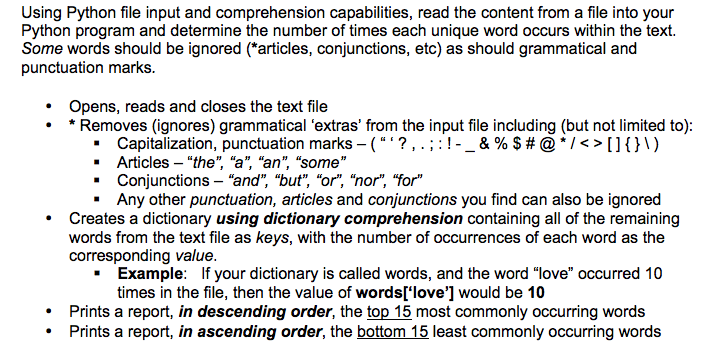Answered step by step
Verified Expert Solution
Question
1 Approved Answer
USING PYTHON IDLE 3.4: Files you can use to test this: NO man thinks more highly than I do of the patriotism, as well as
USING PYTHON IDLE 3.4:





Files you can use to test this:
NO man thinks more highly than I do of the patriotism, as well as abilities, of the very worthy gentlemen who have just addressed the House. But different men often see the same subject in different lights; and, therefore, I hope that it will not be thought disrespectful to those gentlemen, if entertaining, as I do, opinions of a character very opposite to theirs, I shall speak forth my sentiments freely, and without reserve. This is no time for ceremony. The question before the House is one of awful moment to this country. For my own part, I consider it as nothing less than a question of freedom or slavery. And in proportion to the magnitude of the subject, ought to be the freedom of the debate. It is only in this way that we can hope to arrive at truth and fulfill the great responsibility which we hold to God and our country. Should I keep back my opinions at such a time, through fear of giving offense, I should consider myself as guilty of treason towards my country and of an act of disloyalty towards the majesty of Heaven which I revere above all earthly kings.
NEED HELP WITH THIS, PLEASE! :(
Using Python file input and comprehension capabilities, read the content from a file into your Python program and determine the number of times each unique word occurs within the text. Some words should be ignored articles, conjunctions, etc) as should grammatical and punctuation marks. Opens, reads and closes the text file *Removes (ignores) grammatical extras' from the input file including (but not limited to): Capitalization, punctuation marks i: & /S l) Articles "the "a", an "some" Conjunctions and", "but" "or" "nor", "for" Any other punctuation, articles and conjunctions you find can also be ignored Creates a dictionary using dictionary comprehension containing all of the remaining words from the text file as keys, with the number of occurrences of each word as the corresponding value. Example If your dictionary is called words, and the word "love" occurred 10 times in the file, then the value of wordsD'love'l would be 10 Prints a report, in descending order, the top 15 most commonly occurring words Prints a report, in ascending order, the bottom 15 least commonly occurring words Using Python file input and comprehension capabilities, read the content from a file into your Python program and determine the number of times each unique word occurs within the text. Some words should be ignored articles, conjunctions, etc) as should grammatical and punctuation marks. Opens, reads and closes the text file *Removes (ignores) grammatical extras' from the input file including (but not limited to): Capitalization, punctuation marks i: & /S l) Articles "the "a", an "some" Conjunctions and", "but" "or" "nor", "for" Any other punctuation, articles and conjunctions you find can also be ignored Creates a dictionary using dictionary comprehension containing all of the remaining words from the text file as keys, with the number of occurrences of each word as the corresponding value. Example If your dictionary is called words, and the word "love" occurred 10 times in the file, then the value of wordsD'love'l would be 10 Prints a report, in descending order, the top 15 most commonly occurring words Prints a report, in ascending order, the bottom 15 least commonly occurring wordsStep by Step Solution
There are 3 Steps involved in it
Step: 1

Get Instant Access to Expert-Tailored Solutions
See step-by-step solutions with expert insights and AI powered tools for academic success
Step: 2

Step: 3

Ace Your Homework with AI
Get the answers you need in no time with our AI-driven, step-by-step assistance
Get Started


